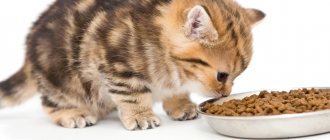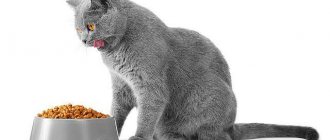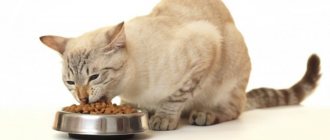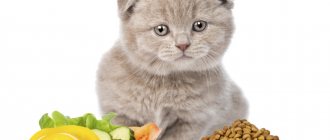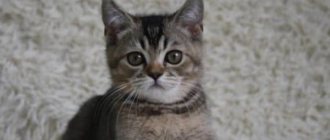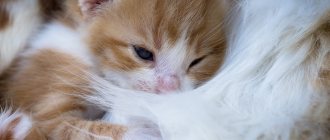There are situations when a cat dies after the birth process or abandons its babies, and in such cases, the owner should know what to feed a month-old kitten without a cat, which will allow the kittens to survive, as well as grow and develop normally.
It is known that the best nutrition for newborn kittens is maternal colostrum and milk, so feeding kittens continues until at least 1.5 months of age.
Earlier weaning from mother's milk can cause psychological disorders in the kittens themselves and in the cat. The immune system of kittens at the age of 4 weeks is not yet mature enough to fight off serious infectious diseases. In addition, cats, being close to kittens, teach them all the necessary rules of personal hygiene, give massages, and teach them how to “hunt.”
It is important to figure out what the owner should do if there is no possibility of natural feeding of newborn kittens, what mixtures and food to select for one-month-old babies and what feeding regimen must be followed.
What and how often to feed a one-month-old kitten
The main nutritional element for a small kitten is cat's milk. Regardless of whether the baby is left without the support of the mother or she is feeding her baby, babies up to a month old can be taught to feed themselves. There is no need to be afraid of this, because sooner or later the cat will still switch to another food. But it’s better to let this happen under your control.
You can start feeding kittens using a bottle and pacifier.
The baby's diet should be complete (nutritious and healthy). The food should be liquid or semi-liquid (similar to regular milk). At 1 month, a kitten can eat “baby” foods:
- Goat's milk (must be diluted with boiled water in a 1:1 ratio).
- Special dry formulas for feeding kittens (can be purchased at a pet pharmacy).
- Low-fat fermented milk products without sugar.
- Liquid porridge made from semolina or rice (the rice must first be crushed).
- Boiled egg yolk (can be mixed with low-fat cottage cheese, but this puree should be fed no more than 2 times a week).
- Simple soups (boiled lean meat + broth without salt, once a week).
- Baby meat or fish puree.
- Boiled lean meat (except pork) in small quantities (must be chopped before feeding).
- Boiled sea fish without salt (boiled fillet must be carefully cleaned of bones and chopped, can be given no more than 2 times a week).
However, 30 days after birth, you should not give your kitten all the approved foods at once. Every day you need to offer one thing. Firstly, this way you can control how the baby reacted to the new food. And secondly, the cat must gradually get used to the change in food. Too sudden changes in a child's diet can lead to serious consequences (allergies, indigestion, diarrhea, vomiting, death, etc.).
When I introduce kittens to a new food, I first let the little ones try it with my finger. If kittens lick your finger, it means they like it. Sometimes these kids turn away and resist, then I resort to cunning. I smear a small amount of food on the kitten’s nose, he has to lick it (so he’ll definitely taste it). You also need to keep an eye on the kittens while eating; the smallest animals can slip and fall into the bowl. By the way, this is why kittens are given complementary foods at the very bottom of the bowl.
Photo gallery: approved products for one-month-old kittens
Goat milk can only be given diluted
Baby food in the form of purees is inexpensive, easy to find, and kittens eat it with pleasure.
Porridge for kittens should be liquid (almost like milk)
Meat can be given separately or in broth
If a kitten is left without cat milk, then it can get most of the nutrients from fermented milk products
I fed mine with Tema (classic) children's cottage cheese, without any additives like banana. Small kittens drink little water, so you need cream with 10% fat content (the approximate fat content of mother's milk), milk is not allowed. Moreover, they ate sour cream at the level of sour cream better. I set it in the morning and it stayed for the whole day. All Agusha's canned children's meats were suitable. Only after 2 months she began to accustom her to soaked dry food for Hills kittens.
Lucia, forum user
https://forum.academ.info/index.php?showtopic=221934
There should also be a bowl of clean water next to the food. Even if it seems to you that the kitten does not drink from it, the water still needs to be changed every day. After eating, dishes must be washed and dried thoroughly. It is important that the dishes are not plastic, because pathogenic microbes can settle in scratches on plastic walls.
Up to a month, kittens need to be fed up to 8 times a day. If you have a month-old baby, feed him 7-8 times, gradually reducing the number of feedings to 6 times a day. Usually such small kittens eat every 4 hours (it is necessary so that the kitten does not have time to get hungry). A warning sign may be a baby's refusal to eat. Of course, the issue may be that the food offered is unattractive, but if the kitten turns away from food several times in a row, then this is a reason to consult a veterinarian. In young animals, diseases progress faster than in adults, so every hour counts.
Starting from four weeks of age, the kitten should be given approximately 50 milliliters of food per 100 grams of weight at a time. Average kittens do not grow more than 200 grams per month, so the approximate volume of a single serving is 100 grams. But you can’t prepare baby food for more than 24 hours - saving time will have a bad effect on the baby’s health.
Should milk and milk substitutes be given?
One-month-old kittens should not be fed only cow's milk.
Every inexperienced kitten owner wonders whether it is possible to replace cat's milk with cow's milk. In fact, cow's milk is not the best nutritional option. The fact is that it contains a lot of lactose (milk sugar). This component causes something like an allergy in felines. Small kittens (up to 4 months) easily tolerate lactose, but it is not recommended to abuse it. You can purchase an alternative to cow's milk - a special substitute. This is a powder for dissolution, it can be bought at any pet store (pet pharmacy).
If you decide to feed your kitten milk or a milk substitute, you need to remember that milk cannot become the main product of the diet. After a month, it can be given to the kitten only 2 times a day. If the kitten came to you already accustomed to milk, then the lactose-containing product can be given in the form of porridge, gradually reducing the amount of milk and increasing the content of cereals and water.
There is a superstition among some breeders: if you feed a fold-eared kitten with cow's milk, its ears will “stand up.” This is supposedly due to the fact that the ears straighten when there is an excess amount of calcium in the body. In fact, all kittens need calcium, regardless of their breed. And drooping ears rise as they grow, but milk has no effect on this. It’s just that sometimes in the fold-eared breed babies are born with “defects”.
Contrary to stories, milk does not affect the shape of the ears of Scottish kittens
If you still want your kitten to eat dairy products, then offer your pet “sour milk”. Low-fat sour cream, fermented baked milk, Varenets - there are many useful and nutritious ingredients here. As a rule, cats like these products. You can also give cheeses in small quantities (the main thing is that they are unsalted). My cat, for example, loves soft cheeses (although I give it a little at a time - two or three cubes 1x1 cm).
How to accustom your pet to solid food
You need to gradually introduce yourself to solid food. But it all depends on what kind of food you choose. For example, if a kitten is fed porridge, then at first it should be a very liquid porridge, and gradually the volume of liquid is reduced by adding more cereal. If you offer your kitten meat, then first add a little boiled and chopped fillet, for example, chicken, to the broth. Gradually the amount of meat can be increased. Some people add boiled meat to porridge. The kitten will quickly taste the taste of the dish.
Cat breeders usually have no problems with porridges and soups. It is more difficult to teach a kitten to eat dishes with pieces of vegetables or meat. Of course, a baby who has been fed cat's milk will not be able to eat solid food from the first day. You will have to spend some time with the kittens while they are learning. The smaller the solid pieces of food, the easier it will be for the animal to start eating. If your pet eats only liquids and leaves pieces of meat in the plate, then try grinding them in a blender at least once. Next time the cat will specifically look for meat even in a bowl of porridge (the instincts of a small predator will make themselves felt).
You need to gradually introduce your kitten to solid food.
What foods should your pet try first?
Of course, you cannot give your kitten raw meat from the first days. The first feeding should be gentle. Many kitten owners start feeding their little pets eggs. It can be raw or boiled yolk. The raw yolk is mixed with milk or a milk substitute. A hard-boiled yolk can also be mixed with milk, but more often it is softened with vegetable oil (1 g). This is necessary to prevent the kitten from choking on the dry product.
Some owners use corn oil (1 teaspoon). Add butter and half the boiled yolk to 50 ml of milk. You should not give your kitten this kind of food all the time. After the first feeding, pay attention to the behavior and condition of the animal. An attentive owner will immediately notice if such food is not suitable for the kitten (vomiting or diarrhea may occur).
I have a familiar breeder who adds dry yeast (2 g) to kitten milk. He believes that it is good for the baby's stomach (switching to a new diet can be traumatic, and yeast makes this procedure easier). But I know that yeast can cause allergies in kittens (and even adult cats), so it is best to consult a veterinarian before using such a supplement.
Video: recipe for porridge for first feeding
How to train a kitten to eat on its own
Teaching your baby to eat on his own does not take much time and effort. Already from the 3rd week of life, kittens are actively interested in how their adult relatives eat. At the same time, kittens are of little interest in the contents of the bowl.
First, placing a saucer in front of your pet, you should invite him to “take a sample” of the new food from his finger. He will quickly realize that it is very tasty and will then try to eat the prepositional delicacy from the bowl. Instincts will already tell you how to eat the offered treat.
At first, it’s best to keep an eye on your kitten’s meals. A baby, captivated by a delicious dinner, can get its paws into the bowl, then it is necessary to explain that this cannot be done. In time he will learn manners.
It is better to start the first complementary food for one-month-old kittens with easy-to-digest and liquid foods. If it was decided to feed the kitten natural food, it could be chopped chicken or beef fillet in broth, or liquid porridge. Gradually, the amount of liquid in a serving decreases, teaching you to eat solid food.
If the pet only drinks from the entire portion, but does not eat its portion, the meat can be ground in a blender to a porridge state. Next time he himself will look for pieces of meat in his portion.
What to feed a 1.5 month old kitten
At 1.5 months, the kitten can already eat on its own. The weight of the animal can range from 500 to 700 grams. At this time, the kitten needs a complete diet. If the baby is fed natural food, the owner should take care of the variety of food. At one and a half months of age, kittens can be fed the same foods as at four weeks, but gradually new foods can be included in the kitten’s diet:
- porridge from buckwheat, rolled oats (without salt and sugar);
- boiled vegetables (cabbage, carrots, broccoli, zucchini, etc.);
- raw meat (veal, lamb, turkey, chicken, etc.);
- offal, raw or boiled (chicken liver, heart, lungs);
- cottage cheese (fat content no more than 9%) 30 g per day;
- raw fish, scalded with boiling water (without bones, scales, etc.) once a week;
- specially grown greens (you can grow it yourself or buy it at a pet store).
When my cat was little, I fed him oatmeal mixed with wet kitten food, or just boiled meat, or chicken, or fish. Once a week it is recommended to give cats liver and eggs. I bought vitamins from DoctorZOO for kittens. He also very often received leftover baby purees (vegetables and meat), cottage cheese, etc.
Tigrasha, forum user
https://forum.say7.info/topic1753.html
The kitten's menu should expand every month
Feeding frequency
A one and a half month old kitten can be fed 5-6 times a day. The daily amount of food should be about 120 grams per day. Some kittens do not eat all the food offered at one time; this cannot be ignored. It may be difficult for the animal to switch to infrequent feedings. This way he will remain half-starved. If you begin to feed the kitten less often, then the portions should be larger.
Your pet may eat less than 120 grams per day, this may be due to the fact that he does not like the food. There is still a possibility that the baby is sick. Consult your veterinarian; frequent refusals to eat indicate poor appetite.
Closer to 2 months, the volume of the daily diet can be increased to 160–180 grams. But here it all depends on the kitten itself. There are more active kids who constantly play and frolic. Such kittens will eat more than their calm brothers.
It is also important what time of day you feed your pet. There are people who go to work in the morning and come late in the evening. This does not mean that you need to feed the baby in the morning and postpone the next meal until the evening. During one dinner, a kitten will not be able to eat all the food allotted to it at once, and saving part of dinner for a night meal threatens to overeat. In such cases, you can feed the kitten in the morning, leave some of the food in a bowl (it will be eaten closer to lunch), and feed it dinner in the evening. In addition, you can ask your neighbors to come in and feed the cat after lunch.
You need to make sure that the kitten does not remain hungry or overeat
Vitamins and supplements
Natural feeding of small kittens may require vitamins. There are vitamin supplements that are designed for kittens from one and a half months of age:
- "Doctor Zoo";
- "Farmavit";
- Kitzim;
- "Biofar";
- "Brevers", etc.
The owner of a kitten should not run to the veterinary pharmacy and immediately buy all the supplements that will be offered to him. First, it is advisable to consult a veterinarian. Specialists are better versed in the world of veterinary drugs. Perhaps your cat already has enough vitamins, but consuming them in excess can lead to hypervitaminosis. And secondly, you need to carefully study the instructions for the vitamin supplement. Some cat breeders make the mistake of buying 2 different supplements with a similar composition. If you decide to purchase at least 2 drugs, then you need to make sure that their components are not repeated.
In general, the instructions for use describe in detail the indications and contraindications for use. The packaging also indicates why certain vitamins are needed. The most common vitamin supplement given to kittens is fish oil. Breeders recommend giving it to animals 2 capsules per week. If fish oil is purchased in capsules, the liquid can be added to food by piercing the capsule shell with a needle.
In pet stores you can buy special treats for kittens with vitamin supplements.
The mistake is made by those cat breeders who try to saturate the animal’s body with vitamins from individual products. For example, I know a family who feed small kittens (up to 2 months) fresh sprat. Allegedly, this fish contains phosphorus, which is so beneficial for animals. In fact, excess phosphorus leads to the deposition of kidney stones. It is precisely because of the risk of developing urolithiasis that cats and kittens are not recommended to abuse fish at all. In addition, a veterinarian I know told me that fish contains an enzyme that can decompose vitamin B1 (thiamine).
What a kitten shouldn't eat
There are some foods that should not be fed to kittens of any age:
- ready-made food from the table (it may contain salt, spices, etc.);
- medicines and vitamin preparations for people;
- sweets (accumulates in the blood);
- pork and lamb (meat is too fatty and can also be infected with parasites);
- river fish (lots of bones, there is a risk of infection with parasites);
- bones (the kitten can seriously damage the esophagus or stomach);
- legumes (not digested);
- potatoes (not digested, causing fermentation, and also have too much starch);
- fatty fermented milk products (including cheese);
- flour.
The danger is that small kittens can beg for a long time and persistently. It can be very difficult to resist such pressure. For example, when my cat was little, she skillfully begged for ice cream. Of course, you can’t pamper kittens with such “goodies” - they’re too fatty and sweet. In addition, various artificial ingredients are now added to ice cream.
Loving owners sometimes spoil their kittens with ice cream, but this is very dangerous.
Rules for introducing complementary foods
At 1.5 months, you should carefully select foods for your pet. When introducing complementary foods to a kitten, you must follow medical recommendations:
- All food should be heated to +24°C. Food that is too hot or cold can harm your pet's digestive system.
- Boiled cereals should have a very liquid consistency. When using milk to cook porridge, it must be diluted in equal proportions with water.
- Nutrition should be varied and balanced.
- The frequency of meals per day is up to 5 times, with an interval of 3 hours between meals.
- Raw minced meat for kittens is strictly prohibited.
- Pork in any preparation is also prohibited. This type of meat is too heavy for the kitten’s digestive tract and can cause a number of serious diseases.
- New products are introduced into the menu gradually: 1 product per day, in small quantities. When introducing a pet to a new treat, the owner must monitor the reaction of his body to avoid allergies or digestive disorders.
- Food should not remain in the bowl. She cleans up after the meal. Starting from 1.5 months, the kitten needs to be gradually accustomed to a certain food intake.
An actively growing baby needs meat. You can give chicken and beef, but without salt and spices. Meat products should be thoroughly chopped.
Is it possible to feed a kitten 1–1.5 months old with ready-made food?
Veterinarians and breeders have been arguing for many years about what is better to feed kittens - ready-made food or natural food. One thing is clear - mixing these types of nutrition is extremely undesirable. Some people choose industrial feed for two reasons:
- Saving time (no need to spend time preparing food).
- Ready-made feeds already contain correctly balanced nutrients, minerals and vitamins.
But those who have made their choice in favor of ready-made food need to know the following:
- You need to stick to one diet. If the house has run out of food, you cannot feed the kitten natural food (the baby’s body will suffer). Consequences: gastroenteritis, intestinal obstruction, etc.
- You cannot “jump” from one food to another. Each brand of food has its own recipes and principles (if you mix food from different brands, an imbalance of microelements or, for example, amino acids may occur).
- You need to choose only high-quality food (premium, super premium or holistic).
But not whiskey, not friskas, and not kitiket: there are special flavoring additives, but nothing useful. There is also food in bags or jars. This, of course, cannot be left in a bowl for a long time, but if there is an opportunity to stop by, then eating three times a day will be enough for him until the small one 250 grams per day is enough for him.
Fretka, forum user
https://forum.academ.info/index.php?showtopic=221934
If you decide to feed your kitten ready-made food, then it should be the best food you could find.
If the food is premium or super premium, there should be no problems, if “economy” such as whiskey, friskas, etc. - whatever. In nurseries, all cats on premium food are healthy and shiny, because... there is a balance of vitamins and microelements, and so you have to calculate everything yourself, and if you are not a specialist, then there will be a lack of vitamins or their overdose, which is even worse.
https://bvf.ru/forum/showthread.php?t=970243
Kittens prefer special wet food (canned food in jars or bags, as well as pates). However, dry food is cheaper, and some veterinarians believe that it is also healthier. There is a significant difference between these two types of feed in drinking mode. Wet food is 70-80% water, but dry food requires a lot of water. Month-old kittens fed the so-called “dry” diet are fed porridge from dry food - the granules are soaked in water. Gradually the amount of water is reduced and the amount of feed is increased. The most popular premium and super premium food for kittens are the following brands:
- Eukanuba Puppy Kitten;
- Royal Canin (Size Nutrition Mini Junior or Mother And Babycat);
- Bosch Sanabelle;
- Hill's Science Plan Kitten;
- Almo Nature;
- Pro Plan Junior, etc.
Photo gallery: some types of food for kittens at 1–1.5 months
Almo Nature food for kittens contains at least 50% animal protein and 14% non-allergenic rice
Bosch Sanabel kitten food is produced in Germany, the product composition is well balanced
Eukanuba food contains a lot of proteins, including 43% animal proteins (domestic chicken)
Hill's is famous for its rich composition of vitamins and minerals, but it may contain a large percentage of difficult-to-digest carbohydrates
"Proplan" can be bought in almost any pet store, it is very popular among Russian breeders
Seeing the price tag on a package of good food, the kitten owner may change his mind. But these numbers seem large only at first glance. After all, you don’t need to give a lot of good food (the kitten won’t remain hungry anyway), and with a balanced diet, you don’t need to buy any additional products (all vitamins are already included in the product).
Akana Grasslands food: A bag of Akana costs 2,250 rubles per 7 kg bag. 7 kg for two kittens for 55 days. The total weight of kittens is 5.72 kg 63.5 g per kitten per day. 1.972 kg per month per kitten. 22.2 g per kilogram of kitten per day. 690 g per kilogram of kitten per month. 20 rubles per kitten per day. 630 rubles per kitten per month.
Squirreland, regular forum visitor
https://forum-wec.com/index.php?showtopic=170823
Of course, a large package of food is always more profitable than several small ones. However, here you should take into account the number of kittens, the amount of food they consume per day and the shelf life of the product. I try to take medium-sized packages, since the food may run out before the kittens eat it. It is advisable to choose the packaging that has the latest production date.
Baby formula
Each kitten's body is individual. If one pet is ready for complementary feeding at 1.5 months, the other is not yet able to eat solid food. In this case, baby food will help - canned meat and vegetables. It is recommended to give them even if it is not possible to purchase expensive holistic products. Rules for feeding infant formula:
- For a 1.5 month old kitten, vegetable and meat purees are suitable.
- Instant baby cereals are suitable for your pet, but they should not contain sugar, fruits or other food additives.
- To breed quick cereals, a special cat's milk substitute is used. You can buy it at a pet store.
- The first complementary food is baby meat puree.
- The owner dips his finger in the puree and applies a small amount of treat to the animal's nose or lips. As soon as he licks a little puree, he will immediately reach for the jar with the treat.
- For 2 days, the basis of the kitten’s diet is baby meat puree. If the animal eats the dish with pleasure and the body tolerates it normally, you can add vegetable puree or porridge. The correct ratio of products: 60% meat puree and 40% porridge or vegetable puree.
If the combination of meat and vegetable puree is not liked by the baby’s body, and this is manifested by disturbances in the digestive system, you need to return to meat puree for 5-7 days. After a while, you can try the combination of products again.
Are there any peculiarities in feeding small kittens of different breeds?
Feeding different kittens may vary depending on the breed.
Caring for any breed has its own nuances. For example, it is not customary to give liver to babies of Russian Blue cats and Gray Nibelungs. It is believed that this product gives the fur a brown tint, although many breeders recommend feeding kittens with liver from at least one and a half months. It is recommended to feed British kittens a nutritious diet. Britons are stocky animals, kittens grow quickly, rapidly gaining weight, but these animals cannot be called lazy. The diet of such a kitten should contain at least 65% meat products, and vegetables - about 25–30%.
Scottish kittens (Scottish Folds and Scottish Straights) under 3 months of age should eat at least 6 times a day. Active cats quickly begin to feel hungry. Some owners of Scottish cats note that the more nutritiously you feed the kitten, the better its coat “fills up.” I had to read recommendations and advice on feeding Scottish cats on forums. One breeder wrote that the more difficult it is to prepare porridge (4-5 grains at a time), the thicker the animal’s fur becomes. And some even choose a mixed type of feeding. Moreover, kittens are given high-calorie foods as an additive to store-bought food.
I feed my Scottish dogs Royal Canin dry. Kittens are on Bebika, adults are on Fit 32. Plus frozen turkey beef. I also give quail eggs with cream to kittens.
kroin, regular visitor to the forum
https://forum-wec.com/index.php?showtopic=170823
Scots need to be fed often and nutritiously
There is a lot of controversy about the nutrition of small Maine Coons. However, every breeder recommends closely monitoring the baby’s diet. Cubs grow large; a three-month-old kitten can be the size of a regular adult cat. The food for such cats should be dense and plentiful, but the kitten should not be overfed (regular overfeeding leads to obesity and other problems).
To teach your Maine Coon to eat on his own: spoon the pate into his mouth. No bottles. Standards are based on weight, read on the food packaging. And no variety: chickens, etc. Nothing except dry meat and pate. The total number of feedings is 5 per day. Pate per feeding - from a teaspoon.
carrot, forum user
https://www.mainecoon-forum.ru/showthread.php?t=46147
With ready-made food, everything is much simpler. Manufacturers of elite baby food take into account the characteristics of breeds. For example, Royal Canin, which produces food for 6 different breeds of kittens, has developed the British Shorthair series. This food is presented in the form of large granules of a special curved shape. The busy British cannot swallow such an “inconvenient” faction; they have to chew it. In addition, the packages of store-bought food always indicate the daily intake for a kitten, the volume of a single serving and other details.
Video: Sphynx kitten wants to eat porridge along with a plate
Tips for feeding kittens at 1–1.5 months
Breeders and novice cat breeders often exchange experiences in keeping kittens on various forums. As a rule, beginners in this business make various mistakes. For example, some people feed their babies sour cream or sour cream, and abruptly replacing mother’s milk with unusually fatty foods leads to trouble.
There is no need to feed milk and sour cream, then there will be no diarrhea.
Nadja K, forum visitor
https://www.zoovet.ru/forum/?tid=7&tem=474920
And some simply share their personal experience in feeding small kittens.
Feed Hills. It is inexpensive and of normal quality. First for kittens, then for cats from 1 to 6, etc. The main rule: clean, fresh water should always be freely available! But only if you are going to keep the kitten on industrial food, you don’t need to give all sorts of vitamins and natural food. Because the gastrointestinal tract of cats is susceptible to changes in the consistency of food - you will get indigestion, at a minimum.
Wormwood, forum user
https://www.woman.ru/relations/medley4/thread/4497058/
Video: kitten eats independently for the first time
Baby food such as puree with meat is, of course, possible, but veterinarians do not recommend it, after all, this is food for children, not for kittens, there are no substances that a kitten needs. I have been feeding mine with Hilsom since I was 1 month old, at the beginning there was only canned food, diluted with warm boiled water, then I gave dry food for kittens, also with water, now the kitten is almost 8 months old, she eats everything too.
Lenka, novice forum user
You can also find a lot of tips and recipes on the Internet. Each recipe is the result of personal experience, built on trial and error.
I started feeding the kittens at three weeks old, starting with scraped meat, chicken and cottage cheese from a syringe. They are 5 weeks old today. They eat a children's version of “kunkina” porridge: grated beef + boiled carrots + chicken stomachs, chicken breast cut into pieces. They eat with pleasure until they are full. They don’t eat the cottage cheese themselves, and they spit out half of it from the syringe. I feed three times a day. In addition, they also apply to the mother.
Ashicoon, forum user
https://www.mainecoon-forum.ru/showthread.php?t=11520
Video: British kittens try mousse
It is difficult to feed kittens over 1 month of age, since they are still accustomed to cat milk. However, even if the cat does not refuse to feed her cubs, many owners still try to organize the first complementary feeding at 1 month (this is how the kitten is prepared for independent feeding). What exactly the first complementary feeding will be depends on what “policy” you follow for further feeding the animal. You can choose a quick way - ready-made food (mixtures, pates for kittens, dry or wet food). And some choose natural feeding. There are some rules that a kitten owner should remember. You also need to remember the list of permitted and prohibited products.
Difficulties of parenting
The process of raising children cannot proceed calmly and measuredly. This contradicts the energetic essence of a growing organism, cognizing its environment, where absolutely everything is interesting. Therefore, you should not change the rules of its existence during the course of the action, as this will break the stereotype of the pupil’s behavior. Prohibitions must be established once and for all; they are unshakable and mandatory.
As the kitten continues to live in your home, you will have questions about why your pet is sneezing, has lost his appetite, and what to do when there is excessive salivation and hair loss.
If there is a violation in maintaining cleanliness, then you must first rule out the disease by contacting a specialist. If everything is in order, and the breakdowns continue, then under no circumstances should you “poke” the kitten’s nose into its Skoda or into the litter box, showing it in such a shameless manner where it should go for its needs. This will only scare him and develop a strong habit of hiding his flaws and hating his litter box. And the reason for this situation may be simple: you don’t like the smell of the filler or the place where the toilet is located.
Don’t be lazy to figure this out and don’t blame it solely on your pet. You must admit your mistakes and try to correct them as quickly as possible while there is still time for this. Your communication with your furry friend cannot be limited to basic procedures, feeding and games. It is a mistake to believe that a cat is not interested in “conversing” with you: communicate as often and as much as possible, she quickly picks up the intonations of the human voice and thanks to this develops her intelligence. Thus, you yourself become the “creator” of your pet’s character, and the more interesting it is, the more interesting it is for you.

